
Leptoceras menziesii, commonly known as rabbit orchid, is a plant in the orchid family, Orchidaceae and the only member of the genus Leptoceras. It is a slender plant, usually found in large colonies and which only flowers after fire. The flowers are small, white, pink and red on a stem up to 30 cm (10 in) tall and is endemic to southern Australia. It was one of the first orchids from Western Australia to be described and was given the name Caladenia menziesii, a name still used by some authorities.

Diuris pardina, commonly known as the leopard orchid or leopard doubletail is a species of orchid which is endemic to south-eastern Australia. It has two or three grass-like leaves and up to ten yellow flowers with reddish-brown marks and blotches.

Pyrorchis, commonly known as beak orchids, is a genus of flowering plants in the orchid family, Orchidaceae and is endemic to Australia. It contains two species which were previously included in the genus Lyperanthus, also known as beak orchids. Both species have fleshy, oval leaves and form colonies which flower profusely after bushfires.

Aphyllorchis queenslandica, commonly known as the yellow pauper orchid, is a leafless terrestrial mycotrophic orchid in the family Orchidaceae. It has up to twelve dull yellow flowers on a thin, fleshy, purple flowering stem and is endemic to tropical north Queensland where it grows in rainforest.

Gastrodia sesamoides, commonly known as cinnamon bells or common potato orchid in Australia and as the pot-bellied orchid or cinnamon sticks in New Zealand, is a leafless, terrestrial saprophytic orchid in the family Orchidaceae. It has a thin, fleshy brown flowering stem and up to twenty five drooping, brownish, self-pollinating flowers that are white inside. Growing in a wide range of habitats, it is native to Australia and New Zealand.

Bromheadia finlaysoniana, commonly known as the pale reed orchid and as Bromheadia pulchra in Australia, is a plant in the orchid family and is native to areas from Indochina to northern Australia. It is a terrestrial orchid with a tough upright, stem and stiffly spreading, elliptic to egg-shaped leaves. There is a long flowering stem with a short zig-zag section near the end where single flowers open in succession. The flowers are white with a yellow labellum.

Prasophyllum elatum, commonly known as the tall leek orchid, snake orchid or piano orchid is a species of orchid in the family Orchidaceae which is endemic to Australia. It is one of the tallest orchids found in Western Australia as well as one of the most common and widespread. It often flowers in large numbers after a bushfire and has a relatively long flowering period.

Caladenia clavigera, commonly known as plain-lip spider orchid or clubbed spider orchid is a plant in the orchid family Orchidaceae and is endemic to Australia. It is a ground orchid which grows as scattered individuals or in small colonies in Victoria, New South Wales and South Australia. It has a single leaf and one or two small yellowish-green and red flowers.
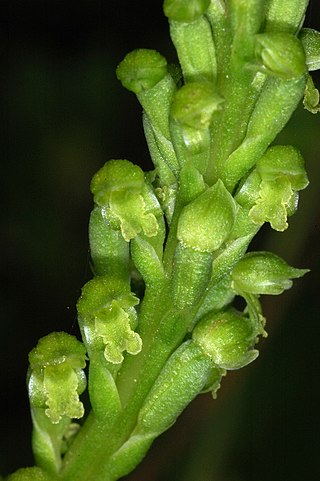
Microtis arenaria, commonly known as the notched onion orchid, is a species of orchid endemic to south-eastern Australia. It has a single hollow, onion-like leaf and up to sixty scented, crowded yellowish-green flowers. It is widespread and common, growing in a wide variety of habitats.
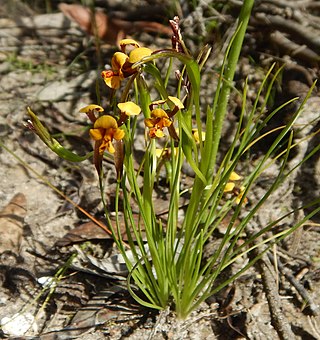
Diuris palustris, commonly known as the swamp doubletail or swamp diuris is a species of orchid which is endemic to south-eastern Australia. It has a tuft of between eight and ten twisted leaves and up to four yellow flowers with brown spots and blotches marks and blotches.
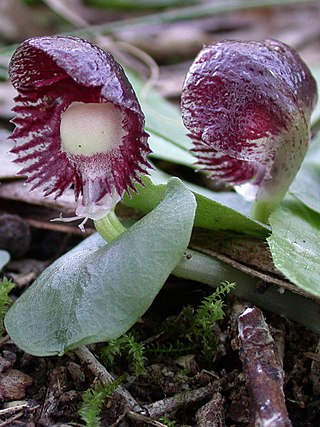
Corybas diemenicus, commonly known as the stately helmet orchid or veined helmet orchid, is a species of terrestrial orchid endemic to south-eastern Australia. It has round or heart-shaped leaf and a reddish purple flower with a central white patch.
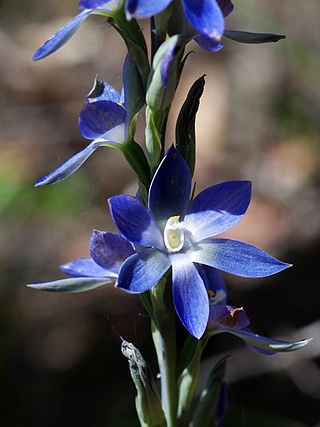
Thelymitra aristata, commonly called the great sun orchid, is a species of orchid that is endemic to south-eastern Australia. It has a single large, thick leaf and bracts and up to forty crowded blue or purplish flowers with darker veins.
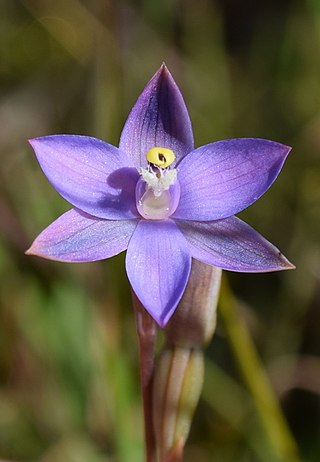
Thelymitra arenaria, commonly called the forest sun orchid, is a species of orchid that is endemic to south-eastern Australia. It has a single long, narrow leaf and up to sixteen purplish self-pollinating flowers which only open on hot days.
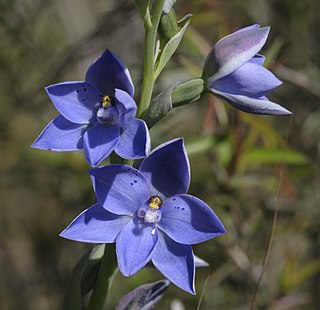
Thelymitra juncifolia, known as the large-spotted sun orchid, is a species of orchid that is endemic to south-eastern Australia and to New Zealand. It has a single thin, dark green leaf and up to five blue flowers with relatively large, dark blue spots on the dorsal sepal and petals. It is similar to T. ixioides but has fewer, smaller flowers with larger dark blue spots.
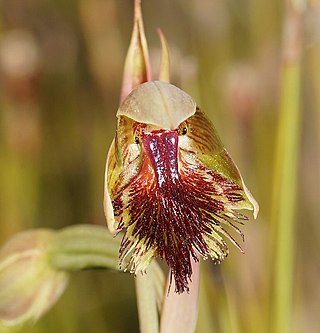
Calochilus herbaceus, commonly known as the copper beard orchid or pale beard orchid, is a species of orchid native to south-eastern Australia and northern New Zealand. It has a single very short, rigid, fleshy leaf and up to eight pale green to brownish flowers with reddish stripes and a purple "beard".

Didymoplexis pallens, commonly known as crystal bells or 双唇兰 , is a leafless terrestrial mycotrophic orchid in the family Orchidaceae. It has up to fifteen small, white, pinkish or brownish flowers on a fleshy yellow flowering stem. The flowers open one at a time, remaining open for a short time. Crystal bells is widely distributed in Asia, Southeast Asia, New Guinea, Australia and some Pacific Islands.

Epipogium roseum, commonly known as ghost orchid, leafless nodding orchid or 虎舌兰 , is a leafless terrestrial mycotrophic orchid in the family Orchidaceae. It has up to sixteen cream-coloured, yellowish or pinkish flowers with an enlarged ovary on a fleshy hollow flowering stem. This ghost orchid is widely distributed in tropical Africa, Asia, Southeast Asia, New Guinea, Australia and some Pacific Islands.
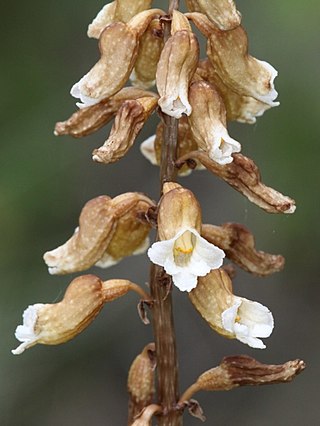
Gastrodia entomogama, commonly known as the Brindabella potato orchid, is a leafless terrestrial mycotrophic orchid in the family Orchidaceae. It has a dark brown or blackish flowering stem with up to sixty brown, warty, tube-shaped flowers. It is only known for certain from the Australian Capital Territory.

Gastrodia procera, commonly known as the tall potato orchid, is a leafless terrestrial mycotrophic orchid in the family Orchidaceae. It has a robust, dark brown to blackish flowering stem with up to seventy cinnamon brown, tube-shaped flowers that are white inside. It grows in high rainfall forest in southeastern Australia.
Gastrodia vescula, commonly known as small potato orchid, is a leafless terrestrial mycotrophic orchid in the family Orchidaceae. It has a very thin, brittle, light brown flowering stem with up to three pale brown flowers that are white on the inside. It is only known from a small area near the border between South Australia and Victoria.



















